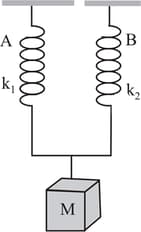MEDIUM
NEET
IMPORTANT
Earn 100
A particle is executing simple harmonic motion with angular frequency , then the angular frequency of its kinetic energy will be
(a)
(b)
(c)
(d)
50% studentsanswered this correctly

Important Questions on Simple Harmonic Motion
EASY
NEET
IMPORTANT
MEDIUM
NEET
IMPORTANT
A body executes simple harmonic motion. The potential energy (PE), kinetic energy (KE) and total energy (TE) are measured as a function of displacement (). Which of the following statements is true?
EASY
NEET
IMPORTANT
EASY
NEET
IMPORTANT
(Where is the displacement from the mean position.)
HARD
NEET
IMPORTANT
A particle of mass executes simple harmonic motion with amplitude and frequency . The average kinetic energy during its motion from the position of equilibrium to the end is
EASY
NEET
IMPORTANT
EASY
NEET
IMPORTANT
EASY
NEET
IMPORTANT
A mass is suspended by means of two coiled springs which have the same length in unstretched condition as in figure. Their force constants are and , respectively. When set into vertical vibrations, the period will be,

